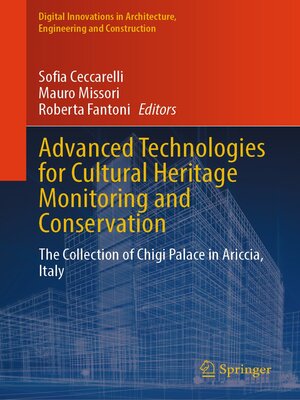Advanced Technologies for Cultural Heritage Monitoring and Conservation
ebook ∣ The Collection of Chigi Palace in Ariccia, Italy · Digital Innovations in Architecture, Engineering and Construction
By Sofia Ceccarelli

Sign up to save your library
With an OverDrive account, you can save your favorite libraries for at-a-glance information about availability. Find out more about OverDrive accounts.
Find this title in Libby, the library reading app by OverDrive.



Search for a digital library with this title
Title found at these libraries:
| Library Name | Distance |
|---|---|
| Loading... |
This book provides the results of an extensive scientific measurements campaign using advanced technologies and innovative non-invasive approaches carried out for the first time in such large numbers inside one of the most important baroque residences in Italy, the Chigi Palace in Ariccia, near Rome (Italy), with the aims of monitoring, characterizing and documenting several kinds of heritage items with different conservative and artistic issues. The analyses involved several research groups from regional universities (Sapienza, Tor Vergata, Roma 3) and research institutions (ENEA, INFN, CNR) and they were performed within the ADAMO project, which was addressed to technologies of analysis, diagnostics and monitoring for the preservation and restoration of Cultural Heritage. The project was proposed by the Centre of Excellence at the Technological District for Cultural Heritage (DTC) financed by the Lazio Region. At the Chigi Palace, important collections of paintings, documents, statues and wall decorations are preserved, dating back from the 16th up to the 18th centuries. The purpose of this book is twofold: it provides an overview of methodologies and technologies currently available in the field of heritage science, through the presentation of their in situ applications for the study of different artworks and materials; furthermore, it shows how the non-invasive analyses and the integration of diagnostic results are useful and sometimes crucial, for the overall understanding of heritage items, their conservation status, and for their correct conservation. This book is addressed at a large audience with both humanistic and scientific backgrounds, focusing the reader's attention on the information gained from multidisciplinary studies, also allowing a curious look at scientific methodologies applied to an art-historical context.







